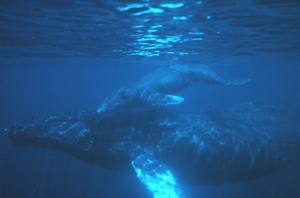Marine Mammal Species Description
Humpback Whale
Megaptera novaeangliae
(Borowski, 1781)

Photo credit: Dave Glickman, NOAA Photo Library
Classification
Order: Cetacea
Family: Balaenopteridae
Alternate Common Names: Bunch, hump whale, hunchbacked whale
Status: ESA Endangered / MMPA Depleted
Description:
Length: 46-56 ft (14-17 m)
Weight: 55,100-99,200 lbs (25,000-45,000 kg)
Humpback whales are sexually dimorphic, with females tending to be slightly longer than males. Their flippers are extremely long, about one-third of their total body length. These whales have a small dorsal fin that can be shaped like a small hump or a triangular shaped fin. Humpback whale flukes have a variable color and have a serrated or a toothed edge. They have bumps on their heads and lower jaws that have small stiff hairs. They have between 20-50 ventral grooves or pleats that extend from their lower jaw to the naval. These whales are in the suborder Mysticeti, or the baleen whales. Baleen whales do not have teeth, but have plates attached to their upper jaws. These baleen plates are hard, but flexible, which baleen whales use to filter their food from the water. Humpback whales are black or dark gray overall and have a mottled gray and white underside. North Pacific humpback whales typically have flippers with white underneath and black above. North Atlantic humpbacks tend to have all white flippers.
Habitat:
Humpback whales occur through oceans of all temperatures and depths. In the summer, they are seen in coastal areas and near the continental shelf and in the winter they are seen around islands and over reefs. They occur by themselves or in groups of two to three. Larger numbers can occur in breeding areas and where there is an abundance of food.
Feeding:
Humpback whales feed on krill and small fish. Humpback whales gulp large amounts of water and prey while they are feeding. They have been seen working together to concentrate or herd prey into smaller areas to make feeding easier. Sometimes humpback whales make ?nets? or clouds of bubbles that they use to help crowd prey fish into a smaller area. Humpback whales typically do not feed when they are on the calving grounds.
Reproduction:
Humpback whales become sexually mature at about 5 years old. Breeding and calving occur in the tropics in the winter. Females typically have one calf every two years although sometimes they can give birth two years in a row. The gestation period is approximately 11-12 months. Females give birth to a single calf, commonly in mid-winter. Calves nurse for about 10 months, and remain with their mothers for an additional 2 months. Calves start to feed on their own around six months old. Male humpback whales are also known for their long, complex songs that they sing which is likely to help them attract a mate. Some whale songs can last up to 20 minutes and be repeated for hours.
Other:
Barnacles commonly attach themselves to the flippers and flukes of humpback whales. Humpback whales are well known for their acrobatics and singing. These whales are some of the most active of the large whales, breaching, and slapping the surface with their flukes or flippers. Some even swim upside down with their flippers out of the water.
Distribution / Range:
Humpback whales occur in all oceans worldwide. They spend most of the year, from spring until fall, in feeding areas in the cold temperate areas to near the polar. They migrate to the tropics to spend the winter in the calving grounds. This migratory trip for some individuals is almost 5,000 miles (8,050 km). Some individuals may not migrate every year. Individuals that migrate typically return to the same area where they were brought as a calf with their mothers.
Similar species:
Humpbacked whales, when viewed a close range, are hard to mistake for another species. However, blue and sperm whales are the most similar to humpback whales.
Notes:
References:
American Cetacean Society. 2004. American Cetacean Society Fact Sheet. http://www.acsonline.org/factpack/humpback.htm. Accessed January 2012.
Clapham, P. 1999. Humpback whale, Megaptera novaeangliae. In The Smithsonian Book of North American Mammals. Wilson, D.E. and S. Ruff, eds., 256-258. Smithsonian Institution in association with the American Society of Mammologists, Washington DC.
Clapham, P.J. 2009. Humpback Whale - Megaptera novaeangliae. In: Encyclopedia of Marine Mammals 2nd Ed. Perrin W.F., B. Würsig, and J.G.M. Thewissen, eds. Academic Press, New York, pp. 582-585.
Jefferson, T.A., S. Leatherwood, and M.A. Webber. 1993. FAO species identification guide. Marine mammals of the world. Rome, FAO. 320 p. 587 figs.
Reilly, S.B., Bannister, J.L., Best, P.B., Brown, M., Brownell Jr., R.L., Butterworth, D.S., Clapham, P.J., Cooke, J., Donovan, G.P., Urbán, J. and Zerbini, A.N. 2008. Megaptera novaeangliae. In: IUCN 2011. IUCN Red List of Threatened Species. Version 2011.2. www.iucnredlist.org. Downloaded on 09 January 2012.

 Marine Mammals of Georgia
Marine Mammals of Georgia